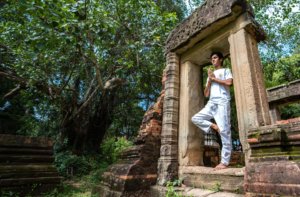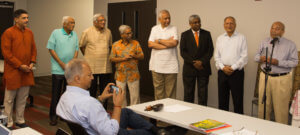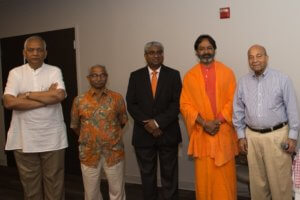For the vast majority of people on the planet, the only conceivable human pursuits and actions (karma) possible are limited to the realms of Security and Pleasure (artha and kāma). But within those realms there are infinite possibilities—many branches and numerous branches too (bahu-śākhā hyanantāś ca)[1]. Our innumerable desires (kāma), centered on our likes and dislikes, (rāga and dveṣa) lead to effort and action (karma), which yield results (phalam), which are either in keeping with our expectations or not—and lead to pleasure and pain, (sukha and duḥkha), fear and anger (Bhaya and krodha). And so, we go around and round, bound by karma life after life (karmabandha)[2]. For many, attaining a certain measure of security in life is, in and of itself, a constant and never-ending struggle, almost a daily battle. This is borne out by the extraordinary inequality in wealth and income distribution in the world. For those who have attained a measure of security, all there is left to do seems to be the pursuit of never-ending varieties of pleasure, enjoyment, and power (bhogaiśwarya-gatiṁ prati)[3] until they are no longer able to do so. Some may hope to attain heaven after death (svargaparāḥ)[4] at least in a western context, while in a Hindu context, there is one more thing to aspire for i.e. a better birth in one’s next life (janma karmaphala pradām)[5]. In any case, almost universally, our inner disposition is inextricably mixed up with our outer circumstance—acquiring and protecting (yoga kṣemaḥ)[6] the money in the bank, how our investments are doing, the well-being of our families and friends, the association and the esteem of our social peers, our titles and accomplishments and so on.
Until one awakens to the possibility of mokṣa.

In the Bhagavad Gītā, Krishna holds out the possibility of a radical dissociation of one’s inner disposition from one’s outward circumstances, exemplified by the ideal of the sthita-prajña[7] whose abiding peace is centered on the Self alone (ātmanyevātmanā tuṣhṭaḥ)[8] and is unconcerned with the anxieties of acquiring and protecting (niryoga-kṣema ātmavān)[9] material things. Without this awakening of a desire for mokṣa, and thereafter jñānam, neither jñānayoga nor karmayoga, as two lifestyles (dvividhā niṣhṭhā)[10] have any relevance. Sanyāsa as a lifestyle, actively and deliberately embraces tremendous physical and financial insecurity i.e., no income, no medical insurance, no savings, and no retirement plan—at least that is how it ought to be—–notwithstanding the many sanyāsins, who seem to continue to have worldly business interests. Yet, in the midst of this physical and financial insecurity and uncertainty, the (vidvat) sanyāsin abides in a settled and almost unperturbed inner security, or that is how he or she ought to be. Indeed, there are very few people who can attain this equipoise in the face of the crushing burden of economic insecurity, while still pursuing mokṣa and jñāna (vividiṣa sanyāsa).
Even though we may develop an awareness of all of these attachments being temporary and time bound, (anityam), it is not easy to walk away from it all—giving up the security and comfort of a life as we know it, in favor of a life that is entirely unknown and uncertain. The transition from gṛhastha to sanyāsa is not easy to make. In Hindu thought, vānaprasthāśrama is structured as a stage in life which is transitional, when one gradually extricates oneself from worldly interests. The vana (Forest) symbolizes a retreating away from the hustle and bustle of the everyday kurukṣetra that each of us find ourselves in. And karmayoga is the critical shift in attitude[11] that enables this transition and can even constitute a committed lifestyle as an alternative to sanyāsa. Making and viewing pleasure and pain, gain and loss, victory and defeat as essentially the same (sukha-duḥkhe, lābhālābhau, jayājayau, same kṛitvā)[12], prepare for battle (yuddhāya yujyasva)[13] says Krishna—once again articulating a paradox. How does one engage deeply with the battles of the world, if at the same time, one does not care in the least for how they turn out?
The critical ingredient that transforms karma into karmayoga is the discernment of mokṣa as the singular and final commitment in life, to the exclusion of all other interests. There is a certain clarity (niścaya) that has arisen in the mind, regarding the transitory nature of existence in the world, (nitya– anitya vastu viveka) that is no longer easily shaken by the entanglements with the world (nistrai-guṇyo bhava)[14] where innumerable outcomes, experiences, and desires can easily carry one’s buddhi away (avyavasāyinām)[15]. The evenness of mind, (samatva)[16] that is at the heart of karmayoga[17], in the face of success and failure, (jayājayou)[18] pleasure and pain (sukhaduḥkha)[19], profit and loss (lābhālābhau)[20]—which are of a material nature (prakṛti– trai-guṇya)[21] arises from three sources: first, the practical recognition that as a human being, we have jurisdiction (choice, authority, power – adhikāra)[22] over the realm of action alone, (karmahetu)[23] but not over the realm of results of those actions (karmaphala hetu)[24]; second, the assimilated understanding that the results of our actions are governed by laws of this world, both seen and unseen, not within our own jurisdiction but of that of Īśvara; and third, in any case, we are no longer yearning for results within the material sphere (trai-guṇya), and that our commitment to mokṣa has assumed a singular and unshakable priority in our lives i.e., we wish to know (jñāna) and be more fully that which we have come to know—an ātmavān.[25] Without the discernment of mokṣa as our ultimate purpose of human existence, and its attendant end to all other forms of seeking[26], one is still embroiled in worldly life—pursuing various ends and enjoining Īśvara to actively join in the task of accomplishing the results that we are aspiring for, which is the condition of most human life. Our karma and our attachments to the karmaphalam may be tempered by prasāda buddhi[27] but is yet to fully transform into a karmayoga.
[1] Bhagavad Gita, Chapter 2, Verse 41, Gita Home Study Program, Page 256
[2] Bhagavad Gita, Chapter 2, Verse 39, Gita Home Study Program, Page 249
[3] Bhagavad Gita, Chapter 2, Verse 43, Gita Home Study Program, Page 262
[4] Ibid.
[5] Ibid.
[6] Bhagavad Gita, Chapter 2, Verse 45, Gita Home Study Program, Page 266
[7] Bhagavad Gita, Chapter 2, Verse 55, Gita Home Study Program, Page 310
[8] Bhagavad Gita, Chapter 2, Verse 55, Gita Home Study Program, Page 310
[9] Bhagavad Gita, Chapter 2, Verse 45, Gita Home Study Program, Page 266
[10] Bhagavad Gita, Chapter 3, Verse 3, Gita Home Study Program, Page 373
[11] Bhagavad Gita, Gita Home Study Program, Page 254
[12] Bhagavad Gita, Chapter 2, Verse 38, Gita Home Study Program, Page 248
[13] Ibid.
[14] Bhagavad Gita, Chapter 2, Verse 45, Gita Home Study Program, Page 266
[15] Bhagavad Gita, Chapter 2, Verse 41, Gita Home Study Program, Page 256
[16] Bhagavad Gita, Chapter 3, Verse 48, Gita Home Study Program, Page 282
[17] Ibid.
[18] Bhagavad Gita, Chapter 2, Verse 38, Gita Home Study Program, Page 248
[19] Ibid.
[20] Ibid.
[21] Bhagavad Gita, Chapter 2, Verse 45, Gita Home Study Program, Page 266
[22] Bhagavad Gita, Chapter 2, Verse 47, Gita Home Study Program, Page 270
[23] Ibid.
[24] Ibid.
[25] Bhagavad Gita, Chapter 2, Verse 45, Gita Home Study Program, Page 266
[26] Bhagavad Gita, Gita Home Study Program, Page 269
[27] Bhagavad Gita, Gita Home Study Program, Page 281









